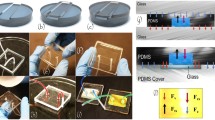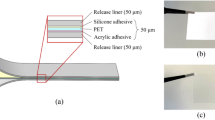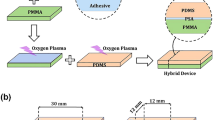Abstract
A cost-effective and simply handling bonding method using siloxane-based adhesion promoter is introduced to increase the adhesion strength between cured PDMS and various substrates. The working mechanism of adhesion promoters is based on post-cure reaction in PDMS curing and they have similar chemistry compositions with PDMS prepolymers. It is experimentally investigated and proved that the adhesion strength of the resulted interface depends on –SiH group and Pt catalyst in adhesion promoters and molecular structures and polarity of substrates surfaces. By modifying their compositions uniform and perfect adhesion can be obtained for different substrates and meet different markets requirements, e.g., PDMS and glass which could be applied for biology, chemistry and solar cell fields, FR4 for electronics field and copper for electronics and thermal cooling fields, etc. Also, considering the quality and reliability requirements from potential application markets of microfluidic devices an environmental test procedure is summarized and according to the defined procedure, the environmental stability of realized PDMS-based microfluidic devices with different substrates has been tested with the result that they exhibited excellent stabilities and suitability for mass production.









Similar content being viewed by others
References
Armani D, Liu C (2000) Re-configurable fluid circuits By PDMS elastomer micromachining. J Micromech Microeng 10:80–84
Auroux P-A, Iossifidis D, Reyes DR, Manz A (2002) Micro total analysis system Ι: introduction, theory and technology. Anal Chem 74:2637–2652
Balslev S, Jorgensen AM, Bilenberg B, Mogensen KB, Snakenborg D, Geschke O, Kutter JP, Kristensen A (2006) Lab-on-a-chip with integrated optical transducers. Lab Chip 6:213–217
Cai DK (2008) Optical and mechanical aspects on polysiloxane based electrical optical circuits board. Ph.D Thesis, Technical University of Dortmund
Cai DK, Neyer A (2007) Realization of electrical-optical-circuit-board self-packaging. In: Proceedings on 57th electronic components and technology conference, 2007, pp. 1368–1374, Reno, Nevada, USA
Cai DK, Neyer A (in press a) Polysiloxane based flexible electrical-optical-circuits-board. Microelectron Eng
Cai DK, Neyer A (in press b) Raman, mid-infrared, near-infrared and ultraviolet-visible spectroscopy of PDMS silicone rubber for characterization of polymer optical waveguide materials. J Mol Struct
Cai DK, Neyer A (submitted) PolyDiMethylSiloxane (PDMS) based optical interconnect packaged with FR4
Cai DK, Neyer A, Kuckuk R, Heise HM (2008) Optical absorption in transparent PDMS materials applied for multimode waveguides fabrication. Opt Mater 30:1157–1161
Dokmeci M, Najafi K (2001) Liquid crystal polymer (LCP) for MEMS: processes and applications. J Microelectromech Syst 10(2):197–204
Duffy DC, McDonald JC, Schueller OJA, Whitesides GM (1998) Rapid prototyping microfluidics systems in poly(dimetylsiloxane). Anal Chem 70:4974–4984
Eddings MA, Johnson MA, Gale BK (2008) Determining the optimal PDMS–PDMS bonding technique for microfluidic devices. J Micromech Microeng 18:067001
Ginn BT, Steinbock O (2003) Polymer surface modification using microwave-oven-generated plasma. Langmuir 19:8117–8118
Giorgi G (2004) A theoretical investigation of the Chalk-Harrod and modified Chalk-Harrod mechanisms involved in hybrid integrated circuit building. Comput Chem Mol Dyn 20(5):781–791
Harrison DJ, Fluri K, Seiler K, Fan Z, Effenhauser CS, Manz A (1993) Micromachining a miniaturized capillary electrophoresis-based chemical analysis system on a chip. Science 261(5123):895–897
Haubert K, Drier T, Beebe D (2006) PDMS bonding by means of a portable, low-cost corona system. Lab Chip 6:1548–1549
Jo BH, Van Lerberghe LM, Motsegood KM, Beebe DJ (2000) Three-dimensional micro-channel fabrication in polydimethylsiloxane (PDMS) elastomer. J Microelectromech Syst 9:76–81
Kilby JS (2000) The electrical century: the integrated circuit’s early history. Proc IEEE 88:109–111
Klank H, Kutter JP, Geschke O (2002) CO2-laser micromachining and back-end processing for rapid production of pmma-based microfluidic systems. Lab Chip 2:242–246
Kovacs GT (1998) Micromachined transducers sourcebook. WCB/McGraw-Hill, New York
Madou MJ (2001) Fundamentals of microfabrication: the science of miniaturization. CRC Press, USA
Mainz A, Becker H (1998) Microsystem technology in chemistry sciences, Topics in current chemistry, vol 194. Springer-Verlag, Berlin, Germany
Manz A, Graber N, Widmer HM (1990) Miniaturized total chemical analysis systems: a novel concept for chemical sensing. Sens Actuators B 1:244–248
Manz A, Harrison DJ, Verpoorte EMJ, Fettinger JC, Paulus A, Ludi H, Widmer HM (1992) Planar chips technology for miniaturization and integration of separation techniques into monitoring systems: capillary electrophoresis on a chip. J Chromatogr A 593(1–2):253–258
McDonald J, Duffy D, Anderson J, Chiu D, Wu H, Schueller O, Whitesides GM (2000) Fabrication of microfluidic systems in polydimethylsiloxane. Electrophoresis 21:27–40
Mogensen K, El-Ali J, Wolff A, Kutter J (2003) Integration of polymer waveguides for optical detection in microfabricated chemical analysis systems. Appl Opt 42(19):4072–4079
Petersen K (1982) Dynamic micromechanics on silicon: techniques and devices. Proc IEEE 70(5):420–457
Reichmuth DS, Shepodd TJ, Kirby BJ (2004) On-chip high-pressure picoliter injector for pressure-driven flow through porous media. Anal Chem 76:5063–5068
Reyes DR, Iossifidis D, Auroux P-A, Manz A (2002) Micro total analysis systems. 1. Introduction, theory, and technology. Anal Chem 74:2623–2636
Sakaki S (2004) Theoretical study of reaction mechanism of hydrosilylation reactions. Keiso Kagaku Kyokaishi 1(20):4–9
Samel B, Chowdhury M, Stemme G (2007) The fabrication of microfluidic structures by means of full-wafer adhesive bonding using a poly(dimethylsiloxane) catalyst. J Micromech Microeng 17:1710–1714
Shigeyoshi S, Mizoe N, Sugimoto M (1998) Theoretical study of platinum(0)-catalyzed hydrosilylation of ethylene. Chalk–Harrod mechanism or modified Chalk–Harrod mechanism. Organometallics 17(12):2510–2523
Shoji S, Esashi M (1994) Microflow devices and systems. J Micromech Microeng 4:157–171
Simpson T, Parbhoo B, Keddie JL (2003) The dependence of the rate of crosslinking in poly(dimethyl siloxane) on the thickness of coatings. Polymer 44:4829–4838
Sofla A, Martinb C (2010) A vapor-assisted method for adhering polydimethylsiloxane and glass. Lab Chip 10:250–253
Venter JC et al (2004) Sequence of the human genome. Science 291:1304–1351
Vilkner T, Janasek D, Manz A (2004) Micro total analysis systems. Recent developments. Anal Chem 76:3373–3386
Wang X, Engel J, Liu C (2003) Liquid crystal polymer (LCP) for MEMS: processes and applications. J Micromech Microeng 13:628–633
Xia Y, Whitesides GM (1998) Soft lithography. Angew Chem Int Ed 37(5):550–575
Author information
Authors and Affiliations
Corresponding author
Rights and permissions
About this article
Cite this article
Cai, D., Neyer, A. Cost-effective and reliable sealing method for PDMS (PolyDiMethylSiloxane)-based microfluidic devices with various substrates. Microfluid Nanofluid 9, 855–864 (2010). https://doi.org/10.1007/s10404-010-0596-1
Received:
Accepted:
Published:
Issue Date:
DOI: https://doi.org/10.1007/s10404-010-0596-1




